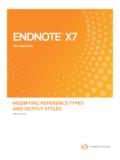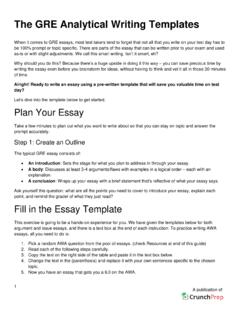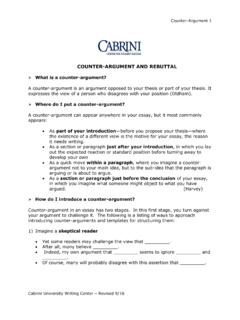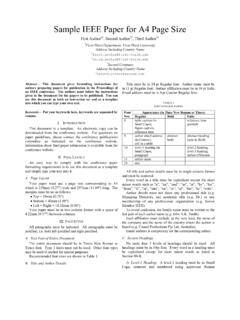Transcription of EndNote X7 for Windows - Modifying Reference Types and ...
1 EndNote X7 FOR WINDOWSMODIFYING Reference TYPESAND OUTPUT STYLESFOR Windows ResearchSoft Modifying Output Styles Page 2 of 55 Document version .1 22 July 2013 INTRODUCTION One of the most powerful features of EndNote is the ability to set a style and have your in-text citations and bibliography automatically change to fit the style you chose. However, occasionally the styles we provide may not exactly meet your needs. For that reason, we provide all the tools you need to create and modify styles yourself. In order to properly understand fully how to modify your output styles, you must first understand how EndNote uses Reference Types and the actual Style Files in order to format your paper to fit your needs.
2 This manual will fill the gap found in the help documentation of the EndNote program itself. Additionally, you can find more information with our online WebEx training found on Thank you for choosing EndNote . ResearchSoft Modifying Output Styles Page 3 of 55 Document version .1 22 July 2013 Table of Contents 1 Reference Types .. 6 INTRODUCTION (WHAT IS A Reference TYPE?) .. 6 Important Points about Reference Types .. 6 Reference Types and Data Entry .. 7 Relationship between Reference Types and Styles, Connections, and Filters .. 7 Setting a Default Reference Type .. 8 THE GENERIC Reference TYPE.
3 8 Using the Generic Type in Styles .. 8 SPECIAL FIELDS .. 8 Author Fields .. 9 Title Fields .. 9 Pages Field .. 9 URL Field .. 10 File Attachments Field .. 10 Figure Field .. 10 Inserting Figures .. 10 Date Stamp Fields .. 10 CUSTOMIZING THE Reference Types .. 10 About the Reference Types Preferences .. 11 Adding, Deleting, and Renaming Fields .. 12 Adding and Deleting Reference Types .. 14 SHARING YOUR Reference TYPE TABLE .. 16 2 INTRODUCTION TO OUTPUT STYLES .. 17 WHAT IS AN OUTPUT STYLE? .. 17 The Output Styles Menu .. 17 The Style Manager .. 18 Navigating the Style Manager.
4 19 Marking your Favorite Styles .. 20 Installing Individual Output Styles .. 20 Using the EndNote Installer to Install Additional Styles .. 20 Installing Individual Output Styles from .. 21 Previewing Styles .. 21 Previewing Styles Using Your Own References .. 22 Copying Styles .. 22 Saving Styles .. 23 ResearchSoft Modifying Output Styles Page 4 of 55 Document version .1 22 July 2013 Deleting Styles .. 23 Renaming a Style .. 23 Reverting Changes to a Style .. 24 Closing a Style .. 24 FOLDER LOCATIONS .. 24 Sharing Customized Styles with Other Users .. 25 3 Modifying STYLES.
5 26 BASIC COMPONENTS OF A STYLE .. 26 The Style Window .. 26 OTHER STYLE OPTIONS .. 27 About this Style .. 27 Anonymous Works .. 27 Page Numbers .. 28 Journal Names .. 28 The Journal Terms List .. 28 Journal Name Settings .. 30 Sections .. 30 Modifying STYLE TEMPLATES .. 31 Citation template .. 31 Multiple Citation Separators .. 32 Year Format .. 32 Bibliography and Footnote Templates .. 32 Changing the Punctuation in a template .. 33 Adding and Removing Fields in a template .. 34 Adding Additional Reference Type Templates .. 35 To add a new Reference type template to a style.
6 35 Defining the Format for the New Reference Type template .. 36 Special Characters in Templates .. 36 Footnote-specific template Options .. 38 Field Substitutions .. 39 Bibliography Layout .. 40 Adding Text before or after Each Reference .. 40 Setting Indents .. 42 Sort Order .. 42 Categories .. 43 Title Capitalization .. 44 4 STYLE EDITING TUTORIAL .. 45 ResearchSoft Modifying Output Styles Page 5 of 55 Document version .1 22 July 2013 INFORMATION FOR AUTHORS .. 45 CREATING THE STYLE .. 46 Setting Anonymous Works, Page Numbers, Journal Names, and Sections .. 47 Setting up the In-Text Citations.
7 47 The Citation Templates .. 48 Ambiguous Citations .. 48 Author Lists .. 49 Author Name .. 49 Numbering .. 50 Sort Order .. 50 Bibliography .. 50 Setting the Bibliography template .. 50 Author Lists, Author Name, Editor Lists and Editor Name .. 51 Field Substitutions .. 52 Layout .. 52 Sort Order .. 53 Title Capitalization .. 53 Footnotes .. 54 Figures and Tables .. 54 AN EASIER WAY: EDITING EXISTING STYLES .. 55 ResearchSoft Modifying Output Styles Page 6 of 55 Document version .1 22 July 2013 1 Reference Types INTRODUCTION (WHAT IS A Reference TYPE?) Your EndNote library can contain references from a variety of different sources, such as books, journal articles, and newspaper articles.
8 We call these different sources Reference Types . EndNote provides built-in forms for these and other common Reference Types . In addition to an all-encompassing Generic Reference type, EndNote has 47 predefined Reference Types as well as three unused ones. The unused Reference Types were created for any user-defined Types that may be necessary. EndNote X7 Standard Reference Types (note that these may vary depending on your version of EndNote ) Aggregated Database Ancient Text Artwork Audiovisual Material Bill Blog Book Book Section Case Catalog Chart or Table Classical Work Computer program Conference Paper Conference Proceedings Dataset Dictionary Edited Book Electronic Article Electronic Book Electronic Book Section Encyclopedia Equation Figure Film or Broadcast Government Document Grant Hearing Interview Journal Article Legal Rule or Regulation Magazine Article Manuscript Map Music Newspaper Article Online Database Online Multimedia Pamphlet Patent Personal
9 Communication Podcast Press Release Report Serial Standard Statute thesis Unpublished Work Web Page Important Points about Reference Types You can assign a particular Reference type to each Reference entered into your library; if you do not, EndNote will automatically use the default Reference type as set in your EndNote Preferences. The Reference Types interface, which is accessible through EndNote s Preferences, determines which fields are available for each of the different Reference Types . The Reference Types interface allows up to 54 different Types of references, each capable of supporting up to 52 fields (including the name of the Reference type).
10 Of the 54 available Reference Types , all but the Generic type can be modified. In the preferences you can add, delete, or rename fields in your Reference Types . You can also hide complete Reference Types . ResearchSoft Modifying Output Styles Page 7 of 55 Document version .1 22 July 2013 The layout of the Generic Reference type should be used as a guide when Modifying or creating Reference Types . Rows reserved for Authors should be used only for names. Do not enter Reference data into the Reference Types preferences. Changes made to the Reference Types preferences apply to all libraries opened under the current user account.







